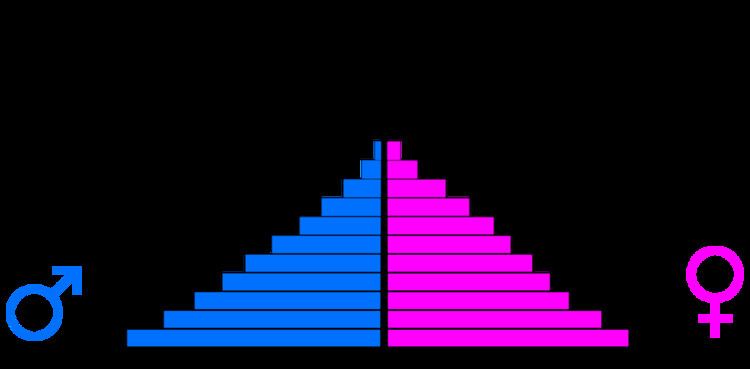 | ||
A population pyramid, also called an age pyramid or age picture is a graphical illustration that shows the distribution of various age groups in a population (typically that of a country or region of the world), which forms the shape of a pyramid when the population is growing. It is also used in ecology to determine the overall age distribution of a population; an indication of the reproductive capabilities and likelihood of the continuation of a species.
Contents
It usually consists of two back-to-back histograms, with the population plotted on the X-axis and age on the Y-axis, one showing the number of males and one showing females in a particular population in five-year age groups (also called cohorts). Males are conventionally shown on the left and females on the right, and they may be measured by raw number or as a percentage of the total population.
Population pyramids are often viewed as the most effective way to graphically depict the age and sex distribution of a population, partly because of the very clear image these pyramids represent.
A great deal of information about the population broken down by age and sex can be read from a population pyramid, and this can shed light on the extent of development and other aspects of the population. A population pyramid also tells how many people of each age range live in the area. There tends to be more females than males in the older age groups, due to females' longer life expectancy.
Types
While all countries' population pyramids differ, the following general types have been identified by the fertility and mortality rates of a country.
In some countries the above "pyramids" are referred to by a description of their shape. The classic example is the pyramid. The stationary pyramid is referred to as a "clock-model" (like the bell in a clock tower). The contracting pyramid is referred to as "onion" shaped, or occasionally as "urn" shaped.
Youth bulge
The expansive case was described as youth bulge by Gary Fuller (1995). Gunnar Heinsohn (2003) argues that an excess in especially young adult male population predictably leads to social unrest, war and terrorism, as the "third and fourth sons" that find no prestigious positions in their existing societies rationalize their impetus to compete by religion or political ideology.
Heinsohn claims that most historical periods of social unrest lacking external triggers (such as rapid climatic changes or other catastrophic changes of the environment) and most genocides can be readily explained as a result of a built-up youth bulge, including European colonialism, 20th-century fascism, rise of Communism during the Cold War, and ongoing conflicts such as that in Darfur and terrorism. This factor has been also used to account for the Arab Spring events. Economic recessions, such as the Great Depression of the 1930s and the Late 2000's recession, are also claimed to be explained in part due to a large youth population who cannot find jobs. Youth bulge can be seen as one factor among many in explaining social unrest and uprisings in society. A 2016 study finds that youth bulges increase the chances of non-ethnic civil wars, but not ethnic civil wars.
A large population of adolescents entering the labor force and electorate strains at the seams of the economy and polity, which were designed for smaller populations. This creates unemployment and alienation unless new opportunities are created quickly enough – in which case a 'demographic dividend' accrues because productive workers outweigh young and elderly dependents. Yet the 16–30 age range is associated with risk-taking, especially among males. In general, youth bulges in developing countries are associated with higher unemployment and, as a result, a heightened risk of violence and political instability. For Cincotta and Doces (2011), the transition to more mature age structures is almost a sine qua non for democratization.
The Middle East and North Africa
The Middle East and North Africa are currently experiencing a prominent youth bulge. "Across the Middle East, countries have experienced a pronounced increase in the size of their youth populations over recent decades, both in total numbers and as a per- centage of the total population. Today, the nearly 111 million individuals aging between 15 to 29 living across the region make up nearly 27 percent of the region’s population." Structural changes in service provision, especially health care, beginning in the 1960s created the conditions for a demographic explosion, which has resulted in a population consisting primarily of younger people. It is estimated that around 65% of the regional population is under the age of 30.
The Middle East has invested more in education, including religious education, than most other regions such that education is available to most children. However, that education has not led to higher levels of employment, and youth unemployment is currently at 25%, the highest of any single region. Of this 25%, over half are first time entrants into the job market.
The youth bulge in the Middle East and North Africa has been favorably compared to that of East Asia, which harnessed this human capital and saw huge economic growth in recent decades. The youth bulge has been referred to by the Middle East Youth Initiative as a demographic gift, which, if engaged, could fuel regional economic growth and development. "While the growth of the youth population imposes supply pressures on education systems and labor markets, it also means that a growing share of the overall population is made up of those considered to be of working age; and thus not dependent on the economic activity of others. In turn, this declining dependency ratio can have a positive impact on overall economic growth, creating a demographic dividend. The ability of a particular economy to harness this dividend, however, is dependent on its ability to ensure the deployment of this growing working-age population towards productive economic activity, and to create the jobs necessary for the growing labor force."
